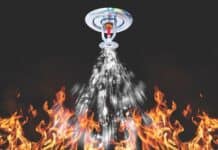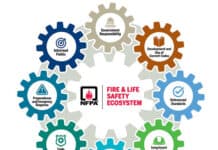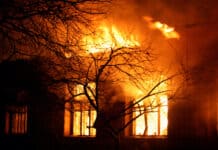Tag: National Fire Protection Association (NFPA)
NFPA, CCFS Offer Tips For Campus Fire Safety Month
NFPA and the Center for Campus Fire Safety provide steps to reduce fire risk in dorms, off-campus, and Greek housing.
Emergency Preparedness: Fire Sprinkler System Retrofits
Whether you're planning a renovation, retrofit, or new construction, there are many considerations when choosing materials for a fire sprinkler system.
News From NFPA: Sprinkler System ITM And Owner Responsibilities
Under NFPA 25, building owners have specific responsibilities for the inspection, testing, and maintenance (ITM) of water-based fire protection systems.
News From NFPA: Return To Office Considerations For People With Disabilities
During the pandemic, building configurations or uses may have changed in new and significant ways. These can have life safety implications, particularly for people with disabilities.
Facility Safety Is A 360° Task
During 2021, the National Fire Protection Association (NPFA) marked its 125th year of protecting people and property.
News From NFPA: Modifying Sprinkler Systems In Existing Facilities
A renovation or redesign to a building layout may require the sprinkler system be brought up to date, and NFPA 13 addresses this scenario.
Fire Prevention Week 2021: Tips For Businesses
QBE North America provides tips to help businesses prevent fires and mitigate losses if a fire does occur.
Water-Based Fire Protection: Options For Sourcing Water
Whether it's a public water supply, tanks, and other source, here are considerations to examine if a water supply will be sufficient for a facility.
ASSA ABLOY Launches “Upgrade Your Openings”
ASSA ABLOY introduced its “Upgrade Your Openings” program to support facility managers in integrating touchless and automated solutions to create safer, healthier environments.
Mar-Bal’s Fire Resistant Wastebasket
The UL Classified and CSFM Listed line of Waste-Safe wastebaskets will contain a fire without burning, melting, or collapsing.
Natural Hazards And Buildings
Whether hurricanes, wildfires, or earthquakes, threats from nature call for renewed look at emergency preparedness plans.
NFPA Releases New Report On Fire In The U.S.
Research highlights factors that have reduced loss since the America Burning report was released in 1973, and areas where work is still needed.
News From NFPA: Remote Inspections, Construction Sites, And Cannabis Facilities
These three issues are among the timely topics the National Fire Protection Association has addressed recently, with a virtual event on June 22 to delve deeper.
National Electrical Safety Month Includes Focus on Workplace, Buildings
Sponsored by the Electrical Safety Foundation International (ESFI), this year's theme for the annual campaign is “Connected to Safety,” focused on emerging technology.
Sprinkler Systems And Maintenance
Keeping up with regular inspections, testing and maintenance of sprinkler systems in buildings is vital to ensure proper operation.
News From NFPA: Fire Safety On Construction Sites
Are you emphasizing a culture of safety during construction, alteration, and demolition projects?
News From NFPA: Inspection And Testing Of Fire Doors In Facilities
Facility managers have a critical role in ensuring that fire doors are maintained in good working condition after these are installed in a building.
News From NFPA: Connecting The Dots With ITM Data Exchange
Inspection, testing and maintenance (ITM) of fire protection systems plays a significant role in managing facility risks.
NFPA Releases Fact Sheet On Ammonium Nitrate Dangers
Available in English and Spanish, this resource for code officials, business owners, and facility management was developed following the August 2020 explosion in Beirut, Lebanon.
Fire Safety For Commercial Kitchens: 8 Recommendations
2020 Fire Prevention Week from NFPA includes serving up guidance to restaurant facility professionals.


































![[VIDEO] Collect Asset Data at the Speed of Walking a Building](https://facilityexecutive.com/wp-content/uploads/2024/02/maxresdefault-324x160.jpg)